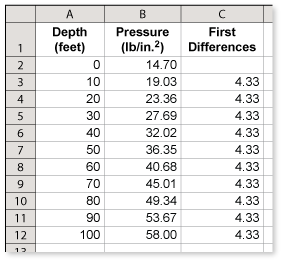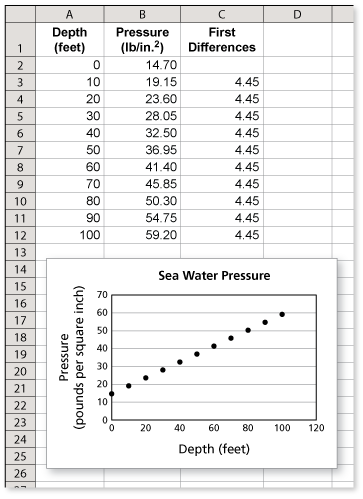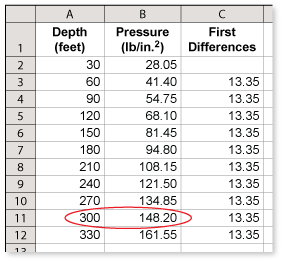-
The table shows the pressures at various depths of freshwater. Does the table relating depth and pressure represent a linear pattern? Explain your reasoning. (See Example 1 and Example 2.)
-
Enter the data into a spreadsheet. You can see that the pattern is linear by observing that the first differences are equal.
Comments (0)These comments are not screened before publication. Constructive debate about the information on this page is welcome, but personal attacks are not. Please do not post comments that are commercial in nature or that violate copyright. Comments that we regard as obscene, defamatory, or intended to incite violence will be removed. If you find a comment offensive, you may flag it.
When posting a comment, you agree to our Terms of Use.Showing 0 commentsSubscribe by email Subscribe by RSSThere are no comments. -
-
The table shows the pressures at various depths of freshwater.
Use a spreadsheet to graph the data. Is the graph linear? (See Example 1 and Example 2.)
These comments are not screened before publication. Constructive debate about the information on this page is welcome, but personal attacks are not. Please do not post comments that are commercial in nature or that violate copyright. Comments that we regard as obscene, defamatory, or intended to incite violence will be removed. If you find a comment offensive, you may flag it.
When posting a comment, you agree to our Terms of Use. -
The table shows the pressures at various depths of freshwater. How much does the pressure increase for every foot of depth? Explain your reasoning. (See Example 1 and Example 2.)
-
Enter the data into a spreadsheet. Notice that each time the depth increases by 10 feet, the water pressure increases by 4.33 pounds per square inch. So, each time the depth increases by 1 foot, the pressure will increase by about 0.43 pounds per square inch.
These comments are not screened before publication. Constructive debate about the information on this page is welcome, but personal attacks are not. Please do not post comments that are commercial in nature or that violate copyright. Comments that we regard as obscene, defamatory, or intended to incite violence will be removed. If you find a comment offensive, you may flag it.
When posting a comment, you agree to our Terms of Use. -
-
The table shows the pressures at various depths of freshwater.
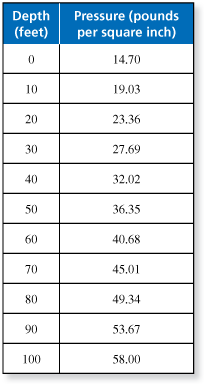
Use the table to write a formula that relates the depth in feet to the pressure in pounds per square inch. (See Example 1 and Example 2.)
These comments are not screened before publication. Constructive debate about the information on this page is welcome, but personal attacks are not. Please do not post comments that are commercial in nature or that violate copyright. Comments that we regard as obscene, defamatory, or intended to incite violence will be removed. If you find a comment offensive, you may flag it.
When posting a comment, you agree to our Terms of Use. -
For seawater, depth and pressure are related as follows.

Use a spreadsheet to make a table for the formula. Then graph the data and verify that the points on the graph lie on a line. (See Example 1 and Example 2.)
-
Enter the formula into a spreadsheet. Then sketch a graph. From the graph you can see that the pattern is linear. Notice that each time the depth increases by 10 feet, the water pressure increases by 4.45 pounds per square inch.
By comparing this data with that in Exercises 1-4, you can see that seawater is heavier than freshwater.
These comments are not screened before publication. Constructive debate about the information on this page is welcome, but personal attacks are not. Please do not post comments that are commercial in nature or that violate copyright. Comments that we regard as obscene, defamatory, or intended to incite violence will be removed. If you find a comment offensive, you may flag it.
When posting a comment, you agree to our Terms of Use. -
-
For seawater, depth and pressure are related as follows.

The recreational diving limit for a scuba diver is 130 feet. Find the pressure at this depth. (See Example 1 and Example 2.)
These comments are not screened before publication. Constructive debate about the information on this page is welcome, but personal attacks are not. Please do not post comments that are commercial in nature or that violate copyright. Comments that we regard as obscene, defamatory, or intended to incite violence will be removed. If you find a comment offensive, you may flag it.
When posting a comment, you agree to our Terms of Use. -
For seawater, depth and pressure are related as follows.

The wreck of the Lusitania lies about 300 feet beneath the Celtic Sea. Find the pressure at this depth. (See Example 1 and Example 2.)
-
One way to answer the question is to use a spreadsheet. You can see that at a depth of 300 feet, the pressure is about 150 pounds per square inch.
Another way to answer the question is to enter 300 feet into the formula given above.

"During the First World War, as Germany waged submarine warfare against Britain, the ship [Lusitania] was identified and torpedoed by the German U-boat U-20 on 7 May 1915 and sank in eighteen minutes. The vessel went down eleven miles (19 km) off the Old Head of Kinsale, Ireland, killing 1,198 of the 1,959 people aboard, leaving 761 survivors. The sinking turned public opinion in many countries against Germany, contributed to the American entry into World War I and became an iconic symbol in military recruiting campaigns of why the war was being fought." (Source: Wikipedia)
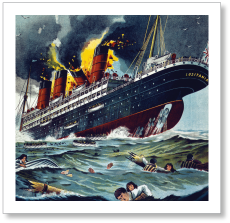
These comments are not screened before publication. Constructive debate about the information on this page is welcome, but personal attacks are not. Please do not post comments that are commercial in nature or that violate copyright. Comments that we regard as obscene, defamatory, or intended to incite violence will be removed. If you find a comment offensive, you may flag it.
When posting a comment, you agree to our Terms of Use. -
-
For seawater, depth and pressure are related as follows.

The wreck of the Titanic lies about 12,500 feet beneath the Atlantic Ocean. Find the pressure at this depth. (See Example 1 and Example 2.)
These comments are not screened before publication. Constructive debate about the information on this page is welcome, but personal attacks are not. Please do not post comments that are commercial in nature or that violate copyright. Comments that we regard as obscene, defamatory, or intended to incite violence will be removed. If you find a comment offensive, you may flag it.
When posting a comment, you agree to our Terms of Use.







